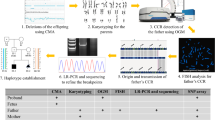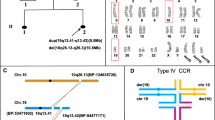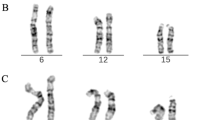Abstract
Some changes in chromosome morphology, detected during cytogenetic analysis, are not associated with clinical defects. Therefore a proper discrimination of harmless variants from true abnormalities, especially during prenatal diagnosis, is crucial to allow precise counseling. In this review we described chromosome variants and examples of chromosome anomalies that are considered to be unrelated to phenotypic consequences. The correlation between the presence of marker chromosomes and a risk of clinical signs is also discussed. Structural rearrangements of heterochromatic material, satellite polymorphism, or fragile sites, are well-known examples of common chromosome variation. However, the absence of clinical effects has also been reported in some cases of chromosome abnormalities concerning euchromatin. Such euchromatic anomalies were divided into 2 categories: unbalanced chromosome abnormalities (UBCAs), such as deletions or duplications, and euchromatic variants (EVs). Recently so-calledmolecular karyotyping, especially whole-genome screening by the use of high-resolution array-CGH technique, contributed to revealing a high number of previously unknown small genomic variations, which seem to be asymptomatic, as they are present in phenotypically normal individuals.
Similar content being viewed by others
References
Anderlid BM, Sahlen S, Schoumans J, Holmberg E, Ashgren I, Mortier G, et al. 2001. Detailed characterization of 12 supernumerary ring chromosomes using micro-FISH and search for uniparental disomy. Am J Med Genet 99: 223–233.
Barber JCK, Joyce CA, Collinson MN, Nicholson JC, Willatt LR, Dyson HM, et al. 1998. Duplication of 8p23.1: a cytogenetic anomaly with no established clinical significance. J Med Genet 35: 491–496.
Barber JCK, Mahl H, Portch J, Crawfurd MD’A, 1991. Interstitial deletions without phenotypic effect: prenatal diagnosis of a new family and brief review. Prenat Diagn. 11: 411–416
Barber JC, Reed CJ, Dahoun SP, Joyce CA, 1999. Amplification of a pseudogene cassette underlies euchromatic variation of 16p at the cytogenetic level. Hum Genet 104: 211–218.
Barber JCK, 2000. An investigation of euchromatic cytogenetic imbalances without phenotypic effect. PhD Thesis, University of Southampton.
Barber JCK, Thomas NS, Collinson MN, Dennis NR, Liehr T, Weise A, et al. 2005. Segmental haplosufficiency; transmitted deletions of 2p12 include a pancreatic regeneration gene cluster and have no apparent phenotypic consequences. Eur J Hum Genet. Epub 2004.
Barber JC, 2005a. Autosomal imbalance and copy number variation without phenotypic effect. Abstracts for 5th European Cytogenetics Conference, Madrid, Chromosome Res Vol. 13 suppl. 1.
Barber JC, Mloney V, Hollox EJ, Stuke-Sontheimer A, du Bois G, Daumiller E, et al. 2005b. Duplications and copy number variants of 8p23.1 are cytogenetically indistinguishable but distinct at the molecular level. Eur J Hum Genet 13: 1131–1136.
Batanian JR, Morris K, Ma E, Huang Y, McComb J, 2001. Familial deletion of (8)(q24.13q24.22) associated with a normal phenotype. Clin Genet 60: 371–373.
Benzacken B, Monier-Gavelle F, Siffroi JP, Agbo P, Chalvon A, Wolf JP, 2001. Acrocentric chromosome polymorphisms: beware of cryptic translocations. Prenat Diagn 21: 96–98.
Blennow E, Anneren G, Bui TH, Berggren E, Asadi E, Nordenskjold M, 1993. Characterization of supernumerary ring marker chromosomes by fluorescence in situ hybridization (FISH). Am J Hum Genet 53: 433–442.
Bortotto L, Piovan E, Furlan R, Rivera H, Zuffardi O, 1990. Chromosome imbalance, normal phenotype, and imprinting. J Med Genet 27: 582–587.
Callen DF, Ringenbergs ML, Fowler JC, Freemantle J, Haan EA, 1990. Small marker chromosomes in man: origin from pericentric heterochromatin of chromosomes 1, 9, and 16. J Med Genet 27: 155–159.
Callen DF, Eyre H, Yip MY, Freemantle J, Haan EA, 1992. Molecular cytogenetic and clinical studies of 42 patients with marker chromosomes. Am J Med Genet 43: 709–715.
Chan NP, Ng MH, Cheng SH, Lee V, Tsang KS, Lau TT, Li CK, 2002. Hereditary duplication of proximal chromosome 1q (q11q22) in a patient with T lymphoblastic lymphoma/leukaemia: a family study using G banding and comparative genomic hybridisation. J Med Genet 39: e79.
Chan S, Dill FJ, Langlois S, Pantzar JT, Lomax B, Rajcan-Separovic E, 2003. Segregation of a novel euchromatic expansion of 8p22 in three generations with no associated phenotypic abnormalities. Am J Hum Genet. 73 Suppl: 316.
Chen CP, Chern SR, Lee CC, Chen WL, Wang W, 2004. Prenatal diagnosis of interstitially satellited 6p. Prenat Diagn 24: 430–433.
Connor M, Ferguson-Smith M, 1998. Podstawy genetyki medycznej. Warszawa: PZWL. [Translation of: Essential medical genetics. Boston: Blackwell Science, 1997].
Cook EH Jr, Lindgren V, Leventhal BL, Courchesne R, Lincoln A, Shulman C, Lord C, 1997. Autism or atypical autism in maternally but not paternally derived proximal 15q duplication. Am J Hum Genet 60: 928–934.
Couturier J, Morichon-Delvallez N, Dutrillaux B, 1985. Deletion of band 13q21 is compatible with normal phenotype. Hum Genet. 70: 87–91.
Davis G, James T, Larkins SA, Dyer SA, Gould CP, Thompson DA, et al. 1999. A large de novo deletion of the long arm of chromosome 10 without apparent clinical effect. J Med Genet. 36: Suppl, 3. 239
De Vries BB, Pfundt R, Leisink M, Koolen DA, Vissers LE, Janssen IM, et al. 2005. Diagnostic Genome Profiling in Mental Retardation. Am J Hum Genet 77: 606–616.
Di Giacomo MC, Cesarano C, Bukvic N, Manisali E, Guanti G, Susca F, 2004. Duplication of 9p11.2-p13.1: a benign cytogenetic variant. Prenat Diagn 24: 619–622.
Docherty Z, Hulten MA, 1993. Rare variant of chromosome 9. Am J Med Genet 45: 105–106.
Eggermann K, Mau UA, Bujdoso G, Koltai E, Engels H, Schubert R, et al. 2002. Supernumerary marker chromosomes derived from chromosome 15: analysis of 32 new cases. Clin Genet 62: 89–93.
Engelen JJM, Moog U, Evers JLH, Dassen H, Albrechts JCM, Hamers AJH, 2000. Duplication of 8p23.1 -> p23.2: A Benign Variant? Am J Med Genet. 91: 18–21.
Engelen JJ, Schrander-Stumpel CT, Theunissen PM, Vaes-Peeters G, Albrechts JC, Hamers AJ 2003. Characterization of a chromosome 8-derived minute marker chromosome using microdissection and FISH in a boy with growth retardation. Am J Med Genet A 30;118: 274–278.
Fantes JA, Mewborn SK, Lese CM, Hedrick J, Brown RL, Dyomin V, et al. 2002. Organization of the pericentromeric region of chromosome 15: at least four partial gene copies are amplified in patients with a proximal duplication of 15q. J Med Genet 39: 170–177.
Fryburg JS, Shashi V, Kelly TE, 1994. Genomic imprinting as a probable explanation for variable intrafamilial phenotypic expression of an unusual chromosome 3 abnormality. Am J Hum Genet. 55: Suppl. A104.
Gardner RJ, Sutherland GR, 2004. Chromosome abnormalities and genetic counseling. Oxford University Press.
Gibbons B, Tan SY, Barber JCK, Ng CF, Knight LA, Lam S, Ng I, 1999. Duplication of 8p with minimal phenotypic effect transmitted from a mother to her two daughters. J Med Genet 36: 419–422.
Guanciali-Franchi P, Calabrese G, Maurizio E, Fantasia D, Colosimo A, Rinaldi MM, et al. 2004. Identification of 14 rare marker chromosomes and derivatives by spectral karyotyping in prenatal and postnatal diagnosis. Am J Med Genet A 127: 144–148.
Hand JL, Michels VV, Marinello MJ, Ketterling RP, Jalal SM, 2000. Inherited interstitial deletion of chromosomes 5p and 16q without apparent phenotypic effect: further confirmation. Prenat Diagn. 20: 144–148.
Harada N, Takano J, Kondoh et al. 2002. Duplication of 8p23.2: a benign cytogenetic variant? Am J Med Genet. 111: 285–288.
Hou JW, Wang TR, 1998. Unusual features in children with inv dup(15) supernumerary marker: a study of genotype-phenotype correlation in Taiwan. Eur J Pediatr 157: 122–127.
Iafrate AJ, Feuk L, Rivera MN, Listewnik ML, Donahoe PK, Qi Y, et al. 2004. Detection of large-scale variation in the human genome. Nat Genet 36: 949–951.
Jalal SM, Schneider NR, Kukolich MK, Wilson GN, 1990. Euchromatic 16p+ heteromorphism: first report in North America. Am J Med Genet 37: 548–550.
Knight LA, Yong MH, Tan M, Ng ISL, 1993. Del(3)(p25.3) without phenotypic effect. J Med Genet. 30: 613.
Langer S, Fauth C, Rocchi M, Murken J, Speicher MR, 2001. AcroM fluorescent in situ hybridization analyses of marker chromosomes. Hum Genet 109: 152–158.
Le Caignec C, Boceno M, Saugier-Veber P, Jacquemont S, Joubert M, David A, et al. 2005. Detection of genomic imbalances by array-based comparative genomic hybridisation in fetuses with multiple malformations. J Med Genet 42: 121–128.
Li S-Y, Gibson LH, Gomez K, Pober BR, Yang-Feng TL, 1998. Familial dup (5)(q15q21) associated with normal and abnormal phenotypes. Am J Med Genet. 75: 75–77.
Li L, Moore P, Ngo C, Petrovic V, White SM, Northrop E, et al. 2002. Identification of a haplosufficient 3.6-Mb region in human chromosome 11q14.3->q21. Cytogenet Genome Res 97: 158–162.
Liehr T, Mrasek K, Weise A, Dufke A, Rodrý’guez L, Martý’nez Guardia N, et al. 2006. Small supernumerary marker chromosomes — progress towards a genotype-phenotype correlation. Cytogenet Genome Res 112: 23–34.
Maltby EL, Barnes ICS, Bennett CP, 1999. Duplication involving band 4q32 with minimal clinical effect. Am J Med Genet. 83: 431.
Mascarello JT, Hubbard V, 1991. Routine use of methods for improved G-band resolution in a population of patients with malformations and developmental delay. Am J Med Genet. 38: 37–42.
Miller I, Songster G, Fontana S, Hsieh CL, 1995. Satellited 4q identified in amniotic fluid cells. Am J Med Genet 55: 237–239.
Millard M, Roman D, Weber C, Wobser J, Moore J, 1998. Chromosome abnormalities and variants with no apparent clinical significance. J Assoc Genet Technol. 24: A151.
Nietzel A, Rocchi M, Starke H, Heller A, Fiedler W, Wlodarska I, et al. 2001. A new multicolor-FISH approach for the characterization of marker chromosomes: centromere-specific multicolor-FISH (cenM-FISH). Hum Genet 108: 199–204.
Oostlander AE, Meijer GA, Ylstra B, 2004. Microarray-based comparative genomic hybridization and its applications in human genetics. Clin Genet 66: 488–495.
Ozikinay F, Ercal D, Ozikinay C, Onay H, Bora E, Erler A, 2005. Two extra euchromatic bands in the qh region of chromosome 9. Genet Couns 16: 45–48.
Overhauser J, Golbus MS, Schonberg SA, Wasmuth JJ, 1986. Molecular analysis of an unbalanced deletion of the short arm of chromosome 5 that produces no phenotype. Am J Hum Genet. 39: 1–10.
Pelly D, Barnes I, 1992. Deletion of 9p in three generations without apparent phenotypic effect. J Med Genet. 29: 210.
Reddy KS, Sulcova V, 1998. The mobile nature of acrocentric elements illustrated by three unusual chromosome variants. Hum Genet 102: 653–662.
Reddy KS, 1999. A paternally inherited terminal deletion, del(8)(p23.1)pat, detected prenatally in an amniotic fluid sample: a review of deletion 8p23.1 cases. Prenat Diagn. 19: 868–872.
Rigola MA, Plaja A, Mediano C, Miro R, Egozcue J, Fuster C, 2001. Characterization of a heritable partial monosomy 18p by molecular and cytogenetic analysis. Am J Med Genet. 104: 37–41.
Ritchie RJ, Mattei MG, Lalande M, 1998. A large polymorphic repeat in the pericentromeric region of human chromosome 15q contains three partial gene duplications. Hum Mol Genet 7: 1253–60.
Robin NH, Harari-Shacham A, Schwartz S, Wolff D, 1997. Duplication 14(q24.3q31) in a father and daughter: delineation of a possible imprinted region. Am J Med Genet. 71: 361–365.
Saxe D, Coleman L, Miley D, Yearall A, Sanders T, May K, 2003. Familial case of duplication 10p without phenotypic effect. Am J Hum Genet. 73 Suppl; 308.
Schoumans J, Anderlid BM, Blennow E, Teh BT, Nordenskjold M, 2004. The performance of CGH array for the detection of cryptic constitutional chromosome imbalances. Med Genet 41: 198–202.
Sebat J, Lakshmi B, Troge J, Alexander J, Young J, Lundin P, et al. 2004. Large-scale copy number polymorphism in the human genome. Science 23: 525–528.
Shaw-Smith C, Redon R, Rickman L, Rio M, Willat L, Fiegler H, et al. 2004. Microarray-based comparative genomic hybridisation (array-CGH) detects submicroscopic chromosomal deletions and duplications in patients with learning disability/mental retardation and dysmorphic features. J Med Genet 41: 241–248.
Strake H, Mrasek K, Liehr T, 2005. Three cases with enlarged acrocentric p-arms and two cases with cryptic partial trisomies. Histochem Cytochem 53: 359–360.
Stumm M, Musebeck J, Tonnies H, Volleth M, Lemke J, Chudoba I, Wieacker P, 2002. Partial trisomy 9p12p21.3 with a normal phenotype. J Med Genet 39: 141–144.
Sumption ND, Barber JCK, 2001. Transmitted deletion of 2q13 to 2q14.1 causes no phenotypic abnormalities. J Med Genet 38: 125–126.
Tabet AC, Dupont JM, Lebbar A, Couturier-Turpin MH, Feldmann G, Rabineau D, 2001. Heteromorphism 18ph+: with or without reproductive consequences? Ann Genet 44: 139–142.
Trimborn M, Grueters A, Neitzel H, Tonnies H, 2005. First small supernumerary ring chromosome carrying 10q euchromatin in a patient with mild phenotype characterized by molecular cytogenetic techniques and review of the literature. Cytogenet Genome Res 108: 278–282.
Tsai CH, Graw SL, McGavran L, 2002. 8p23 duplication reconsidered: is it a true euchromatic variant with no clinical manifestation? J Med Genet 39: 769–774.
Verma RS, Kleyman SM, Conte RA, 1997. Variant euchromatic band within 16q12.1. Clin Genet. 52: 446–447.
Verma RS, Batish SD, Gogineni SK, Kleyman SM, Stetka DG, 1997. Centromeric alphoid DNA heteromorphisms of chromosome 21 revealed by FISH-technique. Clin Genet 51: 91–93.
Von Beust G, Bink K, 1999. Extra euchromatic band in the qh region of chromosome 9. Fetal Diagn Ther 14: 35–37.
Webb GC, Krumins EJ, Eichenbaum SZ, Voullaire LE, Earle E, Choo KH, 1989. Non C-banding variants in some normal families might be homogeneously staining regions. Hum Genet 82: 59–62.
Wilkinson TA, Crolla JA, 1993. Molecular cytogenetic characterization of three familial cases of satellited Y chromosomes. Hum Genet 1: 389–391.
Willatt L, Green AJ, Trump D, 2001. Satellites on the terminal short arm of chromosome 12 (12ps), inherited through several generations in three families: a new variant without phenotypic effect. J Med Genet 38: 723–727.
Witt DR, Lew SP, Mann J, 1988. Heritable deletion of band 16q21 with normal phenotype: relationship to late replicating DNA. Am J Hum Genet. 43 Suppl A127.
Wolff DJ, Raffel LJ, Ferre MM, Schwartz S, 1991. Prenatal ascertainment of an inherited dup(18p) associated with an apparently normal phenotype. Am J Med Genet. 41: 319–321.
Wyandt HE, Tonk VS, 2004. Atlas of human chromosome heteromorphisms. Dordrecht/Boston/London: Kluwer Academic Publishers.
Zaslav AL, Blumenthal D, Fox JE, Thomson KA, Segraves R, Weinstein ME, 1993. A rare inherited euchromatic heteromorphism on chromosome 1. Prenat Diagn 13: 569–573.
Zaslav AL, Pierno G, Fougner A, Jacob J, Shikora G, Kazi R, et al. 2004. Prenatal diagnosis of a rare inherited heterochromatic variant chromosome 4. Am J Med Genet 1; 126: 420–422.
Author information
Authors and Affiliations
Corresponding author
Rights and permissions
About this article
Cite this article
Kowalczyk, M., Srebniak, M. & Tomaszewska, A. Chromosome abnormalities without phenotypic consequences. J Appl Genet 48, 157–166 (2007). https://doi.org/10.1007/BF03194674
Received:
Revised:
Accepted:
Issue Date:
DOI: https://doi.org/10.1007/BF03194674




